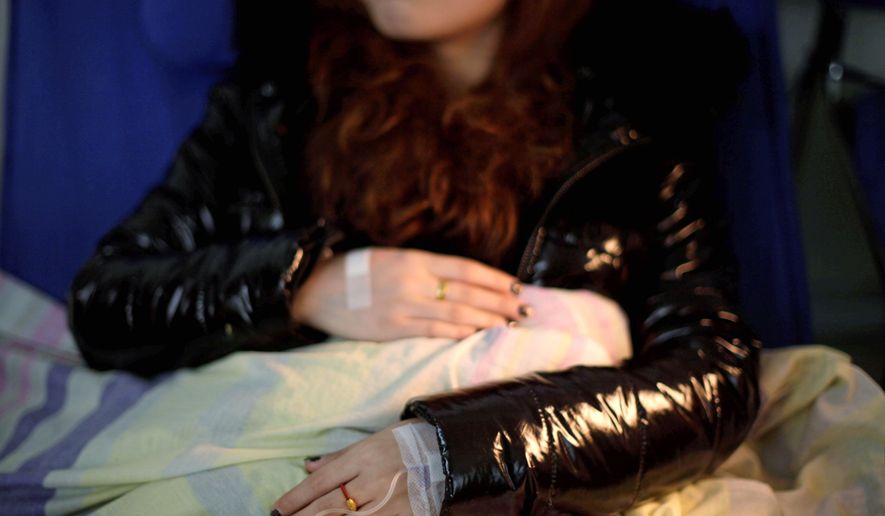XI’AN, China | The leaf-strewn median on Eternal Peace Road hides a grim secret: Numerous tiny fetuses lie in unmarked graves dug by women from the abortion clinic across the street.
The staff at the small clinic in the heart of this ancient city don’t bury most of the fetuses - only those that have reached three or four months, when they clearly resemble miniature babies.
“This big,” says anesthesiologist Liu Jianmin, using her thumb and index finger to measure out the length of a lipstick tube. The burials are a gesture of respect for lives cut short, she adds, and the patients aren’t told.
It is a secret hiding in plain sight, much like the rising rate of abortions among young, unmarried women in China.
While comprehensive data are hard to come by, official figures show abortions are increasing, and Chinese media and experts say many, if not most, of the abortion-seekers are young, single women.
That’s a change from the past, when abortion was used mainly to enforce the government’s one child per couple limit. Today, students are clearly a client base: The Beijing Modern Women’s Hospital offers a government-subsidized “Safe & Easy A+” discount abortion package at 880 yuan ($130). Others advertise in college handbooks.
According to a government tally, 9.2 million abortions were performed in 2008, up from 7.6 million in 2007. But the count only includes hospitals, and state media report the total could be as high as 13 million. If accurate, that would give China among the highest abortion rates in the world.
Many blame the trend on newly liberal attitudes toward premarital sex, and lagging sex education. Bureaucratic red tape and social stigma also deter single women from having a child on their own, and laws bar women from marriage until they are 20, making teen pregnancy virtually unheard of.
These factors and a lack of stigma surrounding abortion, or “artificial miscarriage,” as it’s known here, have helped make it a relatively cheap, widely available option for birth control.
“The moral outrage over having a child before marriage in our society is much stronger than the shame associated with abortion,” said Zhou Anqin, the manager at the clinic in Xi’an, which performs about 60 abortions each month, mostly on students aged 24 or younger.
The two-story facility, which opened in 2007, is one of five operated in China by Marie Stopes International, a London-based not-for-profit group that runs hundreds of clinics globally promoting safe abortions, HIV testing and other services. The fetuses that aren’t buried are discarded as medical waste, as they are in the United States and other countries.
China’s family-planning network is enormous and efficient, a virtual population-control army that promotes contraception and meticulously logs births, abortions and sterilizations — but it focuses mainly on married couples.
Young people are falling through the cracks. A U.N.-funded survey of 22,288 Chinese aged 15-24 by the Peking University Population Research Institute in 2009 found that two-thirds were accepting of premarital sex, but that most “had very limited levels of sexual reproductive health knowledge.”
The survey found 22 percent had had sex before; of those, more than 50 percent used no contraception during their first sexual encounter. A 2009 survey of American high schoolers by the U.S. Centers for Disease Control and Prevention found 46 percent of students had had sex and 85 percent used contraceptives during their most recent sexual activity.
The Chinese can be brutally frank when it comes to abortion. Many feel a fetus isn’t a person until after it’s born — an attitude Beijing sociologist Li Yinhe associates with the country’s once-high infant-mortality rate. Frequent miscarriages and infant death hardened families to the point that babies weren’t traditionally named until 100 days after birth, she noted.
“Luckily, in Chinese culture, people generally feel that before the actual birth, you don’t yet have an actual person, so we have cases of induced abortion at seven and eight months along,” Ms. Li said. “I think this is to China’s advantage from a population control point of view … . China has absolutely no need for the so-called ’right to life’ argument, no need to introduce ideas about abortion as murder, and so on.”
China’s few anti-abortion campaigners are usually Buddhists or Christians. But their activities are low-key because the government keeps a tight rein on grass-roots organizations and religious groups.
China legalized abortion in the 1950s, but it didn’t become common until the government began enforcing a one-child limit to stem population growth.
From fewer than 5 million abortions a year prior to 1979, the numbers jumped to 8.7 million in 1981, a year after the one-child policy was launched. It peaked in 1983 at 14.4 million before coming down as China relaxed the policy to allow rural couples a second child if their first was a girl.
An aggressive, and often coercive, prevention campaign also reduced abortions. In 1983 alone, China sterilized 21 million people and fitted 17.8 million women with intrauterine devices. The next year abortions declined sharply, to 8.9 million.
Abortion remains widely available, but what’s different is the clientele.
“It used to be that Chinese women only had an abortion if the fetus had birth defects or if they got pregnant after having their first child,” says Mrs. Liu, the anesthesiologist.
“Society is different now. It’s much more open, too open actually, and puberty is starting much younger, but schools and parents aren’t discussing these things with the kids.”
Li Shuzhuo, a demographer at the Institute for Population and Development Studies in Xi’an, says it’s clear that there’s been a big shift from post-marriage to pre-marriage abortions over the past 10 years, but academics don’t have access to data that could help them quantify the change.




Please read our comment policy before commenting.